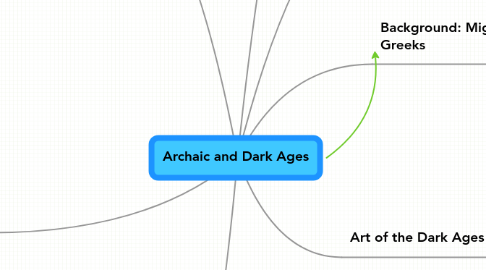
1. Archaic Age: Sculpture
1.1. Kouros Figures
1.1.1. These figures were large.
1.1.2. Large art was created because there was more time, and there was also no war.
1.1.3. These statues always portrayed male, nude figures.
1.1.4. These were usually used for devotionals for gods, or grave markers.
1.2. ARchaic Smile was the fact that the statue was given a certain sort of facial expression.
1.3. Kore Figures
1.3.1. These sculptures were much more different, as they portrayed women instead of men.
1.3.2. They were thought that they are not able to reach arete, or perfection.
1.3.3. They were often displayed reverential to gods.
1.3.4. The Peplos Kore shows a woman, and she is not nude, as opposed to the other male figures. They were actually painted unlike others.
1.3.5. The Chiton Kore figure is much more detailed than it's predecessor, the Peplos.
2. Archaic Age: Origins
2.1. The Archaic age lasted from around 800 to 476 B.C.E.
2.2. Everything was much more calm, because most of the people had already settled into their new homelands,
2.2.1. Labor was divided among themselves.
2.3. During this age, the Greek alphabet came into places, soon to make a much more versatile writing system for the Greeks.
2.4. The Archaic age was also the birth for the great epic stories, written by Homer.
2.4.1. These stories are none other than the Iliad, and the Odyssey. Each story is somewhat interconnected to each other.
3. Archaic Age Ceramics
3.1. Ceramics were often used for trading and storage.
3.1.1. With this, there was the development of different types of vases, one being black figure vases.
3.1.2. These vases were made by heating, then burning the vase, then etching the figures on it.
3.1.3. Exekias came in, making vases, known as the Black Amphora.
3.1.3.1. Bilingual Amphora was a type of pottery that featured black and red figures.
3.2. Red Figures were painted on, whilst black figures were etched using scratches.
4. Background: Migration of Greeks
4.1. Greeks came from nomadic people, settled in northern Greece.
4.2. First greeks were Aiolians
4.2.1. New node
4.3. Second wave of Greeks were the Ionians. First philosophers came from them.
4.4. Third and final wave were the Dorians, in from about 1200 B.C.E
4.4.1. Produced little to no art.
4.5. The dates to the Dark ages were 1200 to 800 B.C.E
5. Art of the Dark Ages
5.1. Had little to no art
5.2. They actually had little to no architecture at the time.
5.3. Some sculptures were made, but because of lack of time, they only mad small ones.
5.3.1. Made a lot of ceramics, those of which include many types of pottery.
5.3.1.1. Hydria: Used to pour water.
5.3.1.2. Lekythos: used to pour oil.
5.3.1.3. Krater: used to mix water and wine.
5.3.1.3.1. New node
5.3.1.4. Amphora: Used to store liquids and dry goods.
5.3.1.5. Kylix: Drinking cup.
5.3.1.6. Oenochoe: Used as a jug for pouring things.
6. Geometric Pottery
6.1. Geometric pottery would often be plain or boring.
6.2. Usually used as a grave stone.
6.3. Late Geometric: the same as earlier eras, only they are a lot larger than the other ones.
6.3.1. Certain vases, such as the Diphylon vase were used as grave markers were as much as five feet tall, because sculptors later on had more time to make them.
6.4. Utilized and relied on geometric shapes in order to create nicer patterns.
7. Characteristics of Greek Vase Painting
7.1. There were six characteristics that painters and sculptors must live by in order to make the art full of life.
7.1.1. 1. Horror Vacui: The fact that the artist must fill every little space with some sort of design.
7.1.2. 2. Rigid division must be in a rational and balanced order.
7.1.3. 3. There must be used of geometric shapes in the art.
7.1.4. 4. Three separate lines must be differently colored.
7.1.5. 5. The handles of a vase must swell out.
7.1.6. 6. Animals and humans must be made of geometric parts.
